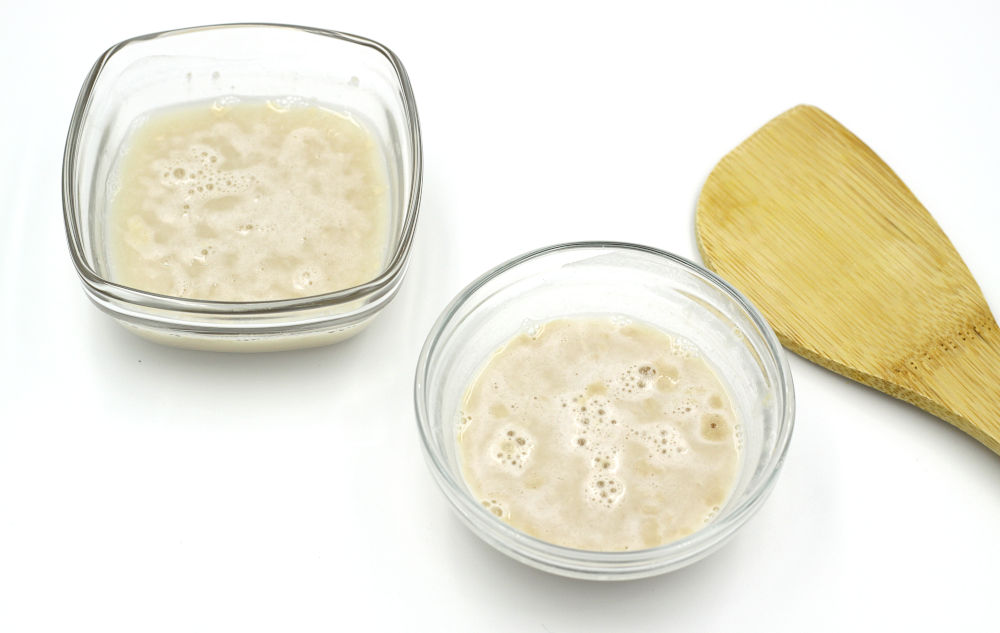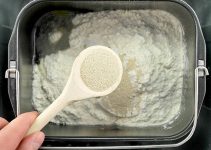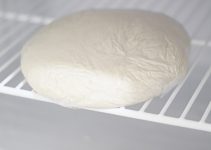There is only one possible answer to the question of what to do if the yeast doesn’t foam: your current yeast should be thrown away and not mixed with the other ingredients. The yeast is no longer alive, which means that it won’t make the dough rise.
Let’s see how we figure out if it’s still good or not. Also, let’s learn how to store yeast properly for longer use.
Contents
My Favorite Yeast for Bread
If you’ve ever read some bread cookbooks, you have probably come across SAF Instant Yeast being mentioned as the best yeast for bread. It’s a strong yeast that many bakers prefer. It doesn’t need to be proofed, it can be mixed right in the dry ingredients. SAF Instant Yeast works in recipes that mention using active dry yeast in a 1:1 substitution.
This is the second best choice that you can make. Since this is dry active yeast, some will prefer proving it because that’s what we’re used to do. However, if it isn’t near its expiration date then you can mix it directly with the other ingredients. If it’s near its expiration date and the yeast doesn’t foam, then it’s time for a new package.
What to Do If the Yeast Doesn’t Foam: Get a New Package

If the yeast doesn’t foam or it only makes a few bubbles, then it means that it won’t be capable of making the dough rise, which makes it useless.
The foam is the indicator that the yeast is alive and ready to make some dough magically rise and take the needed shape for baking.
Let’s see how you can proof yeast to make sure that your yeast is active and good to go. This is the ingredient that has the magic to make the dough rise, you need that foam in order to be sure that it will happen.
If you are aware that your yeast is quite old and you suspect that you haven’t stored it properly, then you need to do a viability test.
You need to proof it. Just to make sure that you won’t waste the other ingredients and waste your time.
How to Proof Yeast

Ingredients
- 1/4 cup lukewarm water
- 1 teaspoon sugar
- 1 packet of yeast (1.4 oz.)
Instructions
1 packet of yeast is equivalent to 7 grams or 1-3/4 teaspoons instant dry yeast or 2-1/2 teaspoons of active dry yeast.
According to bobsredmill.com, the temperature of the water should be 80 degrees F or about 27 degrees C.
If you’re not one for measuring precisely, just mix 1 cup lukewarm water with 1 teaspoon sugar and 1 tablespoon yeast. It should still work for proofing yeast and it will foam if it’s still active.
First dissolve the sugar a bit in the lukewarm water and then add the packet of yeast.
The sugar is needed because yeast consumes various sugars and then releases alcohol and carbon dioxide. These are the things that make the bread rise.
If you have an active yeast on your hands, then it will start bubbling immediately and make a nice layer of foam at the top of the water in 5 to 10 minutes. If you still want to hold onto some hope, give it 15 minutes. But once that’s up, you’ll know for sure if you have a viable leaving agent or not.
If there’s no foam
What to do if the yeast doesn’t foam or just a few bubbles appear? Throw it away and go to the store to get a new package of yeast.
As you can see, that’s the only solution if you want to make sure that your dough will rise and double in size through the fermentation and proofing stages.
This viability test works for both instant and active dry yeast. It also works to proof fresh yeast.
Why is my instant yeast not foaming?
There are only two answers to the question why is the yeast not foaming: it’s past its expiry date or it hasn’t been stored properly.
It means that it’s no longer active and the dough won’t rise if you use it.
There’s only one possible solution to the question of what to do if the yeast doesn’t foam: buy a new package.
How to Store Yeast
Most of us buy yeast in big packages. For example, one of my favorites, the SAF Red Instant Yeast, is sold in a 1 pound pouch.
That can definitely be too much for people who only bake once in a while, whether we’re talking about all kinds of loaves, flatbreads or pizzas.
If you buy your yeast in such a big quantity, the best way is to store it in the fridge in an airtight container.
In the fridge, stored in an airtight container, dry yeast can keep for about 6 months.
Once you estimate that more than half a year might have passed, you should proof your yeast and see if it’s still active or not.
Unfortunately, you already know what to do if the yeast doesn’t foam. It’s time for a new package.
Therefore, if you only bake from time to time, buy your yeast in packets, which only contain 1.4 oz. (7 grams) of yeast.
The advantage is that those unopened packets don’t have to be stored in the fridge, they can be just placed in a cupboard.
Moreover, those unopened packets will keep for at least a year.
In general, the best by date for yeast is 2 years after the day it was packaged. But that only applies for unopened packages.
If you’ve opened it, store it in the fridge in airtight containers for about 6 months.
You could freeze it but it will kill a small percentage of the yeast.
You don’t have to activate instant yeast
If you’re using instant yeast and you’re well aware that it hasn’t gone too long since you’ve gotten your new package, then you can use instant yeast without proofing it to make sure it’s alive.
You just add it to the water, flour and salt and the instant yeast will simply dissolve in the water as you mix and knead the 4 ingredients.
That means that you don’t have to dissolve it in warm water and wait for 10 minutes, until the mixture gets all bubbly. That’s reserved to active dry yeast.
That’s because instant yeast is more stable and has more live cells than ADY. Since it’s fast-acting, you don’t need to dissolve it.
You won’t don’t need to use sugar to activate ADY but you need sugar to proof yeast, to test its viability and see if it’s making foam.
Proof it if you’re unsure of how long it has been since it’s been sitting in your fridge. You now know what the next step is, you know what to do if the yeast doesn’t foam.




